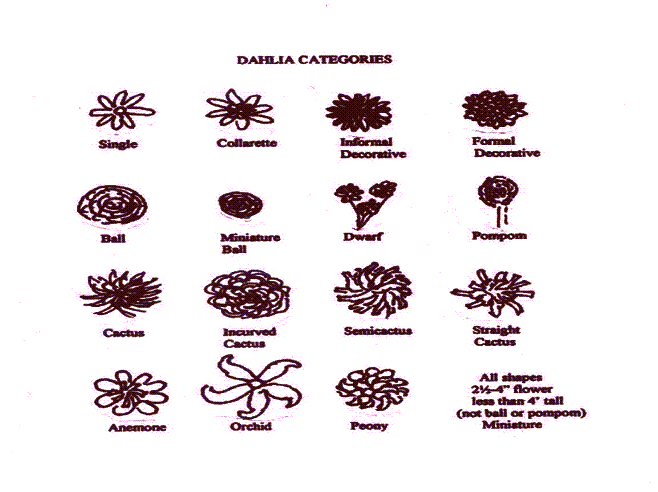|
DAHLIAS - by Carol Rustad
mANY FRIENDS HAVE SAID, I
LIKE DAHLIAS BUT YOU HAVE TO DIG THEM UP EACH FALL!!! That is true.
I guess it all depends on what part of gardening you enjoy. Some
gardeners are really into fertilizing, others love to pick bouquets.
Personally, I just love to dig in the dirt. I get depressed if I
am out of room for digging in new plants. So growing dahlias satisfies
my dirt fix. And what a surprise it is to dig up dahlia tubers
after the first autumn frost and discover they have grown to four
times their size. Just throw them in a five gallon bucket, cover
them with peat moss and keep them in your garage during the winter.
Now that is not so hard, is it? The 14,000
varieties of dahlias are derived from 2-3 species of native plants of
Mexico and Central America. They are available in every color
except blue and their flower size varies in diameter from 1 to 1.
The leaves are opposite and often compound and range in color from green
to grey green to bronze to purple. They bloom from midsummer to
frost. Dahlias come in
four sources but most are purchased in single division tubers:
*root divisions (bit of mother plant stem)
*pot roots (stem cuttings mature in small pots and make tiny clusters of
root)
*green plants from stem cuttings) *seeds (dwarf beddings seedlings not accurate to parent) They like
deeply cultivated well drained soil with plenty of humus, potash,
phosphorus (bonemeal), and wood ashes. Start with 0-20-20
fertilizer 5# / 100 sq. ft. When the plant is established, lightly and
evenly spread 5-10-10 fertilizer. One of the biggest mistakes made with
dahlias is over feeding. Avoid compost, fish fertilizers, and high
nitrogen water soluble types. Weak stems and small blooms will develop.
Dahlias like lots of sun but must have 3-4 hours per day. An east
exposure with shaded roots midday is ideal. Plant after
danger of frost in the spring. Cut clumps into divisions keeping
an eye on each tuber. (The eye is on the neck of the tuber where
it attaches to an old stalk. If there is a question of location of
the eye put the tuber in a warm place to stimulate eye
growth.) Place the tuber horizontally in a 6 hole.
Some gardeners place the tuber in 7 holes and cover the horizontal
tuber with 2 of soil and add more soil as it grows. Insert
support stakes at planting. I use large tomato cages. Let
four branches develop. You may pinch the tops when they are 12
for a more low growing plant. Thinning flower buds increases the
flower size. Our Nebraska wind can be a problem. Entire
branches can be snapped off. That is one of the reasons an east
exposure is better than an unprotected south exposure. Diligent
staking and supporting can overcome most winds. Cut dahlias for
the house in the early morning and immediately put the stems in 2 inches
of hot water (100 degrees) and allow them to sit for four to six hours
before arranging them. Or you can dip the stems into an inch of
boiling water for a second, or sear them with a candle flame. The
intense color of dahlia flowers is absolutely awesome and they come
in many shapes and sizes. A wonderful source for dahlias is Swan
Dahlias P.O. Box 700 Canby, OR 97013, 1-800-410-6540, www.dahlias.com
Here is a guide to the various categories of dahlias:
May 13, 2006
|
